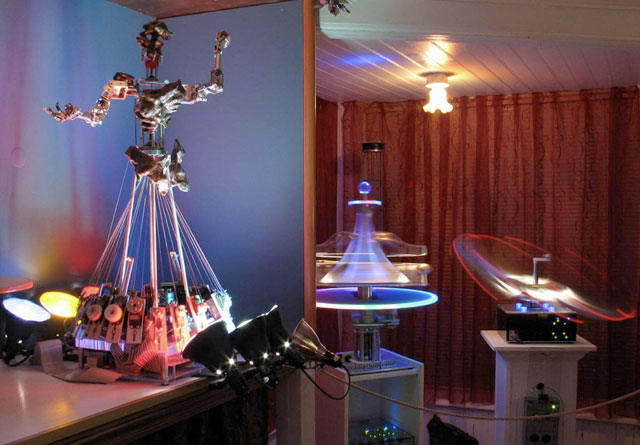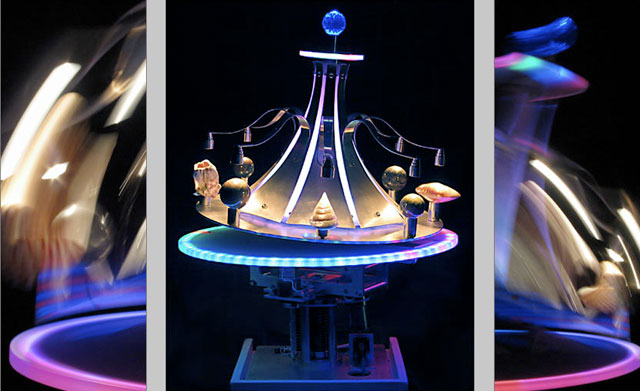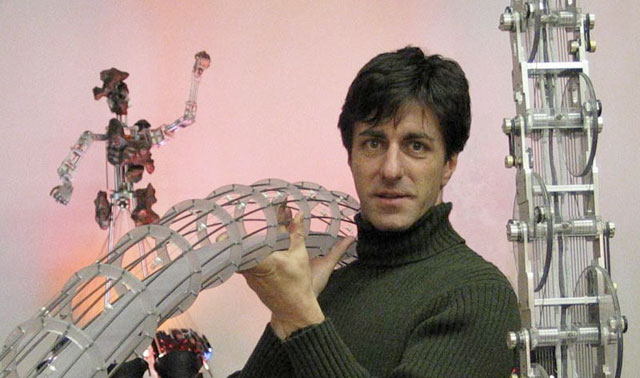a real taste of Carl Pisaturo’s work
 Pisaturo’s Area 2881.
Pisaturo’s Area 2881.A little over a week ago, Wired ran a short but very pleasant piece on the work of enigmatic art machine madman Carl Pisaturo. A local (San Francisco) artist, he seems to be on the trajectory of becoming a visitor-friendly mechanical Sebastian from Blade Runner — who, if you recall in the movie, lived in an environment comprised entirely of mechanical creations.
You can visit his art machine cabinet of curiosities from your laptop: Here at GigaPan, you can give yourself a virtual tour of Pisaturo’s studio, Area 2881. (gigapan.org)
 The Trabant.
The Trabant.
Wired’s piece was short and precise; and though it neglected a front-page link to the artist's website, here's an enjoyable snip:
Tucked away in a quiet residential neighborhood of San Francisco is a little workshop that opens its doors rather infrequently to the outside world. But when it does, it is an electro-mechanical wonderland.
Called Area 2881, after its address, it is a 400-square-foot installation of kinetic and light art housed in an hardware store from the early 1900s.
The Willy Wonka behind it, Carl Pisaturo is an applications engineer by day at Stanford University. When he's not at work, Pisaturo spends his time fashioning the most elaborate objects -- an upper body robot with humanoid range of movements, a to-shoot-and-view-3d-photos/10049554001">3-D photograph viewer and a strobe illusion device that he calls a transmutoscope.
"I wanted to create a living environment of kinetic sculptures," he says.
The transmutoscope, for instance, has a series of slightly different but similar looking cylindrical objects arranged in a circle on a a rotating disk. When strobe lamps fire in sync with the object positions, the transmutoscope pulsates. The cylinders appears stationary yet contracting and expanding.
Other Pisaturo creations include two electro-mechanical robots he calls "slave robots" that can be handled using an external controller, and a three-motor Tilt-a-Whirl-type carousel based on an amusement park ride.
Pisaturo has posted detailed material, design and electrical notes for his creations on his website.
Each sculpture can take months to finish, with all parts custom-made by him."Fully custom mechanical objects with lighting can take a long time," says Pisaturo who does the machining for the metal himself, "from three months to two years in case of the slave robots." (...read more, blog.wired.com)
 to 20px;" />
to 20px;" />
Wired visited Pisaturo's shop, but as evidenced in the comments and in my several days of frustration with their Brightcove player (and even going to the source and having days of video fail) unfortunately the article's accompanying video never came through. Instead, I went to the site we all use despite our better judgment, and came up with these fab videos of Pisaturo's art machines:
 Pisaturo’s Area 2881.
Pisaturo’s Area 2881. The Trabant.
The Trabant.
 to 20px;" />
to 20px;" />